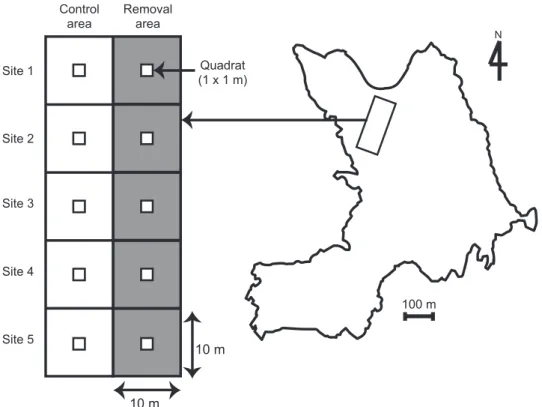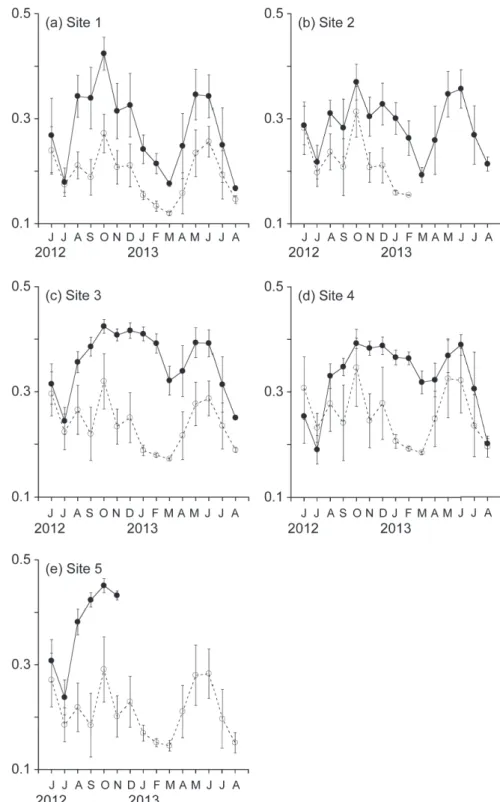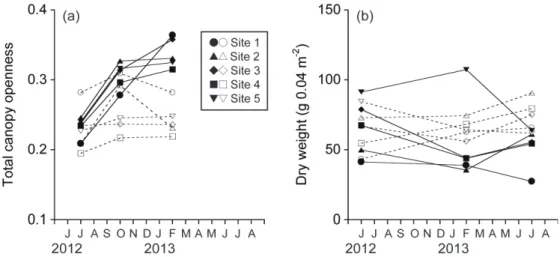Title
Temporal changes in soil water contents of
forests dominated by Casuarina equisetifolia on
Nishijima Island before and after their
eradication
Author(s)
Hata, Kenji, Kawakami, Kazuto, Kachi, Naoki
Citation
小笠原研究, 40: 1-9
Issue Date
2014-03
URL
http://hdl.handle.net/10748/6446
DOI
Rights
Type
Departmental Bulletin Paper
Textversion
publisher
Temporal changes in soil water contents of forests dominated
by Casuarina equisetifolia on Nishijima Island before and
after their eradication
Kenji HATA1*, Kazuto KAWAKAMI2 and Naoki KACHI1
1Department of Biological Sciences, Graduate School of Science and Engineering, Tokyo Metropolitan University, Japan
2Forestry and Forest Products Research Institute, Japan
*Author for correspondence: E-mail ken-hata@tmu.ac.jp, 192-0397, Tel +81-426-77-2585, Fax +81-426-77-2559
Abstract: An invasive woody species, Casuarina equisetifolia Forst. (Casuarinaceae), is strongly
dominant in the forests it invades in the Ogasawara Islands. For the restoration and management of these forest ecosystems, eradication and control programs aimed at C. equisetifolia are ongoing on the islands. The eradication can affect the water balance by altering hydrological processes, such as evapotranspiration, throughfall, stemflow, and rainfall canopy interception. In this study, we showed temporal changes in the water contents of surface soils in forests dominated by C. equisetifolia on Nishijima Island before and after their eradication. Volumetric water contents of surface soils at sites where all trees of C. equisetifolia were killed by herbicide and those of adjacent control sites were measured. The measurements of the soil water contents have been conducted from July 10, 2012 to August 31, 2013 at hourly interval. After August 2012, the soil water contents in the removal quadrats have trended to be higher than those in the control quadrats. The increases in soil water contents just after the removal treatment suggested that death of C. equisetifolia by the treatment would result in increase in soil water content. The complete data set of soil water contents in this study is available in electronic format with the permission of the Ogasawara Research Committee of Tokyo Metropolitan University (island@ tmu.ac.jp).
Keywords: exotic plants, invasive trees, manipulative removal experiment, Ogasawara
Islands, subtropical oceanic island, volumetric water content of soil
Temporal changes in soil water contents of forests dominated
by Casuarina equisetifolia on Nishijima Island before and
after their eradication
Kenji HATA1*, Kazuto KAWAKAMI2 and Naoki KACHI1
1Department of Biological Sciences, Graduate School of Science and Engineering, Tokyo Metropolitan University, Japan
2Forestry and Forest Products Research Institute, Japan
*Author for correspondence: E-mail ken-hata@tmu.ac.jp, 192-0397, Tel +81-426-77-2585, Fax +81-426-77-2559
Abstract: An invasive woody species, Casuarina equisetifolia Forst. (Casuarinaceae), is strongly
dominant in the forests it invades in the Ogasawara Islands. For the restoration and management of these forest ecosystems, eradication and control programs aimed at C. equisetifolia are ongoing on the islands. The eradication can affect the water balance by altering hydrological processes, such as evapotranspiration, throughfall, stemflow, and rainfall canopy interception. In this study, we showed temporal changes in the water contents of surface soils in forests dominated by C. equisetifolia on Nishijima Island before and after their eradication. Volumetric water contents of surface soils at sites where all trees of C. equisetifolia were killed by herbicide and those of adjacent control sites were measured. The measurements of the soil water contents have been conducted from July 10, 2012 to August 31, 2013 at hourly interval. After August 2012, the soil water contents in the removal quadrats have trended to be higher than those in the control quadrats. The increases in soil water contents just after the removal treatment suggested that death of C. equisetifolia by the treatment would result in increase in soil water content. The complete data set of soil water contents in this study is available in electronic format with the permission of the Ogasawara Research Committee of Tokyo Metropolitan University (island@ tmu.ac.jp).
Keywords: exotic plants, invasive trees, manipulative removal experiment, Ogasawara
Introduction
Casuarina equisetifolia Forst. (Casuarinaceae) is an invasive woody species, native to Malaysia,
southern Asia, Australia, and Oceania (Weber 2003), and it has been introduced to many forests in the Ogasawara Islands. It is strongly dominant in the forests it invades and accumulates large amounts of litter under its dense canopy (Hata et al. 2009). This accumulation prevents the initial establishment of native trees (Hata et al. 2010) and alters litter decomposition and litter nitrogen release rates (Hata et al. 2012). For the restoration and management of these forest ecosystems, eradication and control programs aimed at C. equisetifolia are ongoing on the Ogasawara Islands (Government of Japan 2010). However, predicting whether ecosystem functions will be appropriately restored is difficult since information regarding the efficacy of the programs is lacking.
Eradicating C. equisetifolia would result in the loss of large amounts of biomass from the forests, which would alter the forest water balance via changes in water inputs and outputs. For example, the death of large trees, representing large amounts of biomass, often caused reductions in ecosystem water outputs through losses in transpiration (e.g., Bren et al. 2010; Hawthorne et al. 2013). Furthermore, the eradication of C. equisetifolia would cause exposed canopies and reductions in water interception by litter, both of which may increase water inputs. Conversely, canopy exposure and loss of litter may alter water output by enhancing evaporation from the soil surface.
In this study, we showed temporal changes in the water contents of surface soils in forests dominated by C. equisetifolia before and after their eradication.
Study sites and methods
Study sites
This study was conducted in forests dominated by C. equisetifolia on the island of Nishijima (27°07’10’’N, 142°10’00’’E; area = 49 ha; highest altitude = 100 m). In the 2000s, secondary forests dominated by C. equisetifolia were the major vegetation type on Nishijima, while the remaining area was covered by the perennial grass Zoysia tenuifolia, a type of secondary vegetation suppressed by feral goat grazing (Abe 2007). Furthermore, invasive black rats (Rattus
rattus; density ca. 90 individuals ha–1 in 2009; Hashimoto 2009) had damaged various kinds of fruiting vegetation by this time (Abe 2007). Forty-one feral goats were removed in 2002 and 2003, and eradication was confirmed in 2007 (Government of Japan 2010). The eradication allowed for an expansion of forests dominated by C. equisetifolia because of releases from grazing and trampling of the goats; they increased from 4.6 to 17.6 ha between 1979 and 2006
(Abe et al. 2011). In addition, black rats were controlled with rodenticides between 2007 and 2010, and their population density consequently decreased (Hashimoto 2009; K. Kawakami, unpublished data), which also may have promoted the expansion of C. equisetifolia. A program to eradicate C. equisetifolia was implemented in 2010 (Kawakami et al. 2011) and study areas were established to evaluate any effects eradication may have on vegetation recovery processes. On June 10, 2012, five 10 × 20-m sites were selected in forests in dominated by C.
equisetifolia. At each site, removal treatment was conducted in a 10 × 10-m area (east side,
removal area) and not in another 10 × 10-m area (west side, control area) (Fig. 1). A 1 × 1-m quadrat was established at the center of each area.
The forest structure around quadrats in the removal areas was likely similar to that in control areas before C. equisetifolia tree were removed (Table 1). Although there were significant differences in the basal areas of all trees among five sites (nested one-way analysis of variance, ANOVA: F(1, 4) = 20.45, P = 0.006), significant differences in the basal areas of all trees, including dead C. equisetifolia trees, between removal and control areas at each site were not detected (nested one-way ANOVA: F(1, 4) = 0.40, P = 0.56). Including dead trees, the basal area of C.
equisetifolia per total basal area ranged from 68.4% to 100%, but no differences were observed
in the basal area of C. equisetifolia trees between the removal and control areas at each site (nested one-way ANOVA, F(1, 4) = 3.18, P = 0.15).
Fig. 1 Distributions of study sites and quadrats on the island. Control area 100 m N Quadrat (1 x 1 m) Site 1 Site 2 Site 3 Site 4 Site 5 10 m 10 m Removal area
Table 1 Basal area (m2 ha–1, BA) of trees greater than 1.3 m in height in a 100-m2 (10 × 10 m) area
around removal and control quadrats at five sites in June 2012. C, Control quadrat; R, Removal quadrat.
Removal of C. equisetifolia
Removal treatments were conducted on July 5-10, 2012. All C. equisetifolia trees present within the removal areas were killed by herbicide. A glyphosate herbicide (Roundup Max Load; Nissan Chemical Industries, Ltd., Tokyo, Japan) was infused into holes 12 mm in diameter and 100 mm in depth created by an electric knife on the tree trunk at 0.2 m above the ground. The appropriate herbicide volumes to kill trees completely were based on logistic regression models that used
C. equisetifolia diameter at beast height (Fujinuma et al. 2008). We used a minimum of four
holes per a tree at equal distances. Additional holes were made when the appropriate amount of herbicide exceeded the capacity of the four holes. Equal volumes of herbicide were infused into each hole.
Measurements of soil water content
The water content of surface soils was measured at the 10 quadrats. Volumetric soil water content at 10 cm below the surface was measured using a theta probe (SM150, Delta-T Devices, Cambridge, UK) with data logger (MJ-12, Environmental Measurement Japan Co. Ltd., Fukuoka, Japan). The theta probe generates a 100-MHz sinusoidal signal and measures the impedance of the sampling volume (Kaleita et al. 2005). The values produced by the probe (voltage, V) were converted to volumetric soil water content, θv (m3 m–3), using the following equation:
θv = [(1.07 + 6.4V – 6.4V2 + 4.7V3) – 1.3]/7.7 (Delta-T Devices 1999)
The measurements of soil water contents have been conducted from July 10, 2012 to August 31, 2013 at hourly interval. A control quadrat at one site (Site 2) and a removal quadrat at one removal site (Site 5) could not be measure after February 6, 2013 and December 3, 2012, respectively because of technical troubles of the sensor and logger.
Measurements of canopy openness and litter accumulation
Total canopy openness was measured based on hemispherical photographs to estimate light exposure in the removal area. In each quadrat, a hemispherical photograph was taken at noon on July 11, October 6, 2012, and February 7, 2013 (a cloudy day) using a digital camera (Coolpix 880, Nikon, Tokyo, Japan) with a fisheye converter (FC-E9 0.2x, Nikon). Photographs were then analyzed with HemiView 2.1 Canopy Analysis Software (Delta-T Devices) to calculate total canopy openness 0.1 m above the ground. In addition, interval photography has been conducted between July 7, 2012 and July 6, 2013 at 24 hours interval using a digital camera (Recolo, King Jim Co. Ltd., Tokyo, Japan).
To measure amounts of accumulated litter, we collected litter at one randomly chosen 0.2 × 0.2-m location near each quadrat on June 21, 2012, February 7 and July 14, 2013. Litter was dried at 70ºC for 72 h and weighed.
Results and Discussion
There were roughly similar trends in temporal changes in monthly mean values of soil water content and their variances among five sites (Fig. 2). The soil water contents in the removal quadrats drastically increased in August 2012 but not in the control quadrats. After August 2012, the soil water contents in the removal quadrats have trended to be higher than those in the control quadrats. The increases in soil water contents just after the removal treatment suggested that death of C. equisetifolia by the treatment would result in increase in soil water content.
Mean values and variances in soil water contents trended to be different among months regardless of the presence of the removal treatments. Those between January and March 2013 trended to be smaller than those in other months. The differences in the variances may be related to amounts of rainfall. Mean values of monthly precipitation between 1969 and 2013 are 70.4 mm in January, 57.9 mm in February and 70.9 mm in March, which are smallest three values (Japan Meteorological Agency, Tokyo, Japan). Lack of rainfall can reduce soil water contents and their variances.
Total canopy openness in the removal areas trended to increase after the removal treatments (Fig. 3a). In July 2012, no significant differences in total canopy openness between removal and control quadrats (nested-ANOVA, F(1, 4) = 0.04, P = 0.86). On the other hands, quadrats where C.
equisetifolia had been removed had marginally and significantly higher values of total canopy
openness than control quadrats in October 2012 (nested-ANOVA, F(1, 4) = 4.87, P = 0.09) and February 2013 (nested-ANOVA, F(1, 4) = 145.95, P < 0.001), respectively. The increases in total canopy openness would be due to exposure of forest canopies by death C. equisetifolia and subsequent defoliation. It is consistent with results of the interval photography that leaves of C.
Fig. 2 Monthly mean values (± standard error) of volumetric water content in surface soils in quadrats.
equisetifolia have been defoliated completely after approximately one month of the treatment.
It was observed that most of the accumulated litter was dead leaves of C. equisetifolia. Amounts of accumulated litter trended to decrease after the treatment (Fig. 3b). Significant differences in dry weights of accumulated litter between the removal and control quadrats were not detected in June 2012 and February 2013 (nested-ANOVA, F(1, 4) = 0.04, P = 0.86, F(1, 4) = 0.62, P = 0.48, respectively). In July 2013, the dry weights in the removal quadrats were significantly higher than those in the removal quadrats (nested-ANOVA, F(1, 4) = 10.81, P = 0.03). The reduction of the litter in the removal quadrats suggested decomposition of the dead leaves without litterfall after death of C. equisetifolia trees.
We demonstrated temporal changes in water contents of surface soils in forests dominated by C.
equisetifolia before and after their eradication. Data of the soil water contents in this study can be
used for further analyses. The complete data set of soil water contents in this study is available in electronic format with the permission of the Ogasawara Research Committee of Tokyo Metropolitan University (island@tmu.ac.jp).
Acknowledgements: We thank the Ministry of Environment and the Department of National Forests
in the Ogasawara Islands for allowing us to conduct this study. This work was partly supported by JSPS KAKENHI Grand Numbers 24710274 and 25241025, and the Global Environment Research Coordination System Fund of the Ministry of the Environment of Japan. Dr. Shin Abe provided valuable information for discussion in this study. Professor Atsushi Ishida and Dr. Atsushi Kume provided insights into methods of soil water content measurement.
Fig. 3 (a) Total canopy openness and (b) dry weights of accumulated litter near quadrats. Solid and dash
References
Abe T (2007) Predator or disperser? A test of indigenous fruit preference of alien rats (Rattus
rattus) on Nishi-jima (Ogasawara Islands). Pac Conserv Biol 13:213–218
Abe T, Yasui T, Makino S (2011) Vegetation status on Nishi-jima Island (Ogasawara) before eradication of alien herbivore mammals: rapid expansion of an invasive alien tree,
Casuarina equisetifolia (Casuarinaceae). J For Res 16:484–491
Bren L, Lane P, Hepworth G (2010) Longer-term water use of native eucalyptus forest after logging and regeneration: the Coranderrk experiment. J Hydrol 384:52–64
Delta-T Devices (1999) Thetaprobe soil moisture sensor. User manual, Ml1-UM-1.21. Cambridge, UK: Delta-T Devices
Fujinuma J, Hata K, Kachi N (2008). Field experiment on the effects of a herbicide on an invasive alien tree, Casuarina equisetifolia, in the Bonin (Ogasawara) Islands, southern Japan. Ann Rep Ogasawara Res 31:19–29 (in Japanese)
Government of Japan (2010) Nomination of the Ogasawara Islands for inscription on the World Heritage List. Government of Japan, Tokyo, Japan (in Japanese)
Hashimoto T (2009) Eradication and ecosystem impact of rats in the Ogasawara Islands. Glob Environm Res 14:93–101 (in Japanese)
Hata K, Kato H, Kachi N (2009) Community structure of saplings of native woody species under forests dominated by alien woody species, Casuarina equisetifolia, in Chichijima Island. Ogasawara Res 34:33–50
Hata K, Kato H, Kachi N (2010) Litter of an alien tree, Casuarina equisetifolia, inhibits seed germination and initial growth of a native tree on the Ogasawara Islands (subtropical oceanic islands). J For Res 15:384–390
Hata K, Kato H, Kachi N (2012) Leaf litter of the invasive Casuarina equisetifolia decomposes at the same rate as that of native woody species on oceanic islands but releases more nitrogen. Weed Res 52:542–550
Hawthorne SND, Lane PNJ, Bren LJ, Sims NC (2013) The long term effects of thinning treatments on vegetation structure and water yield. For Ecol Manag 310:983–993 Kaleita AL, Heitman JL, Logsdon SD (2005) Field calibration of the theta probe for Des Moines
lobe soils. Appl Eng Agric 21:865–870
Kawakami K, Abe S, Aoyama Y (2011) Environmental characteristics of alien Casuarina
equisetifolia forests on Nishijima, the Bonin Islands. Ogasawara Res 36:1–19
Weber E (2003) Invasive plant species of the world: a reference guide to environmental weeds. Wallingford, UK: CABI Publishing.
ABSTRACT IN JAPANESE



